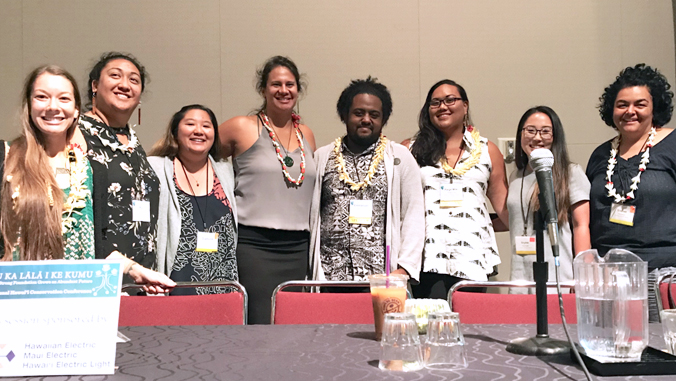
A session called Aʻohe pau ka ʻike i ka hālau ho ʻokahi: Advancing modern science with Hawaiian knowledge was featured at the 25th annual Hawaiʻi Conservation Conference, held in late July at the Hawaiʻi Convention Center. The session was proposed and convened by ʻIke Wai students and post-docs Kuʻi Keliipuleole, Brytne Okuhata, Diamond Tachera and Sheree Watson, each with ties to the University of Hawaiʻi at Mānoa School of Ocean and Earth Science and Technology (SOEST).
ʻIke Wai (meaning “knowledge” and “water”) is a National Science Foundation-funded project whose mission is the sustainability of Hawaiʻi‘s water future. Comprised of an interdisciplinary team of researchers, students and educators, ʻIke Wai students and post-docs are especially passionate and driven to solve problems in culturally relevant ways that also inspire community engagement.
“We have students take an active role in their own personal and professional development, and we encourage them to take responsibility for creating and shaping their opportunities,” said Deborah Eason, ʻIke Wai professional development coordinator. “They often identify project or community needs, and organize meetings and activities to try to address those needs.”
Organizing this conference session is a perfect example of the positive outcomes that professional development has on student learning, collaboration and self-actualization.
Session speakers Kiana Frank, Jade Delevaux, Paige Miki Okamura, Kilika Bennett, Uʻilani Au and Katie Kamelamela collectively emphasized the importance of traditional Hawaiian knowledge and place-based learning in informing contemporary science and public policy.
We have students take an active role in their own personal and professional development, and we encourage them to take responsibility for creating and shaping their opportunities.
—Deborah Eason
Frank, an assistant research professor in the SOEST Pacific Biosciences Research Center, shared the ways in which the story of Meheanu informed science of the microbial nitrogen cycle of Heʻeia fishpond. She also used dance videos to engage the public in science learning.
Au, Okamura and Bennett are graduate assistants working at the Institute of Hawaiian Language Research and Translation within the UH Sea Grant College Program. Their talks emphasized that Hawaiian language newspapers hold valuable information which can be used to reconstruct historical weather events and climate patterns, and inform water science and sustainable stewardship.
Kimberly Burnett, an ʻIke Wai economics researcher who attended the conference session, noted, “Okamura’s example of using [Hawaiian language newspapers] to reveal detailed information about the previously unknown [1871] hurricane, and how that evidence was then used to inform/redirect hurricane policy at the legislature” was particularly powerful.
The Papakilo Database is the largest indigenous language repository in the world with more than 125,000 pages sourced from over 100 Hawaiian newspapers (1834–1948). However, 97 percent of this knowledge is yet untapped.
Gregory Chun, an ʻIke Wai social science researcher, pointed out, “We typically don’t view newspapers as a source of ‘knowledge’ per se but, rather, as a source of news and events. It was much different for our kupuna who, as we saw from the selected quotes by Paige [Okamura], Kilika [Bennett] and Uʻi [Au], encouraged people to specifically use their writing (newspapers) to document and preserve traditional knowledge and customs because of their foresight of what change was going to mean for the culture.”
—By Surely Wallace, a UH Mānoa graduate student in the ʻIke Wai program

